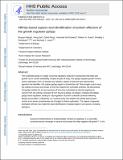| dc.contributor.author | Wang, Boyuan | |
| dc.contributor.author | Dai, Peng | |
| dc.contributor.author | Ding, David | |
| dc.contributor.author | Del Rosario, Amanda M | |
| dc.contributor.author | Grant, Robert A | |
| dc.contributor.author | Pentelute, Bradley L. | |
| dc.contributor.author | Laub, Michael T | |
| dc.date.accessioned | 2020-01-23T23:19:23Z | |
| dc.date.available | 2020-01-23T23:19:23Z | |
| dc.date.issued | 2018-12 | |
| dc.date.submitted | 2018-06 | |
| dc.identifier.issn | 1552-4450 | |
| dc.identifier.issn | 1552-4469 | |
| dc.identifier.uri | https://hdl.handle.net/1721.1/123670 | |
| dc.description.abstract | The nucleotide ppGpp is a highly conserved regulatory molecule in bacteria that helps tune growth rate to nutrient availability. Despite decades of study, how ppGpp regulates growth remains poorly understood. Here, we developed and validated a capture-compound mass spectrometry approach that identified >50 putative ppGpp targets in Escherichia coli. These targets control many key cellular processes and include 13 enzymes required for nucleotide synthesis. We demonstrated that ppGpp inhibits the de novo synthesis of all purine nucleotides by directly targeting the enzyme PurF. By solving a structure of PurF bound to ppGpp, we designed a mutation that ablates ppGpp-based regulation, leading to dysregulation of purine-nucleotide synthesis following ppGpp accumulation. Collectively, our results provide new insights into ppGpp-based growth control and a nearly comprehensive set of targets for future exploration. The capture compounds developed should also enable the rapid identification of ppGpp targets in any species, including pathogens. Keywords: bacteria; enzymes; microbiology; target identification; x-ray crystallography | en_US |
| dc.description.sponsorship | National Institutes of Health (U.S.) (Grant R01GM082899) | en_US |
| dc.language.iso | en | |
| dc.publisher | Springer Science and Business Media LLC | en_US |
| dc.relation.isversionof | http://dx.doi.org/10.1038/s41589-018-0183-4 | en_US |
| dc.rights | Article is made available in accordance with the publisher's policy and may be subject to US copyright law. Please refer to the publisher's site for terms of use. | en_US |
| dc.source | PMC | en_US |
| dc.title | Affinity-based capture and identification of protein effectors of the growth regulator ppGpp | en_US |
| dc.type | Article | en_US |
| dc.identifier.citation | Wang, Boyuan et al. "Affinity-based capture and identification of protein effectors of the growth regulator ppGpp." Nature Chemical Biology 15, 2 (December 2018): 141–150 © 2018, The Author(s), under exclusive licence to Springer Nature America, Inc. | en_US |
| dc.contributor.department | Massachusetts Institute of Technology. Department of Biology | en_US |
| dc.contributor.department | Massachusetts Institute of Technology. Department of Chemistry | en_US |
| dc.contributor.department | Massachusetts Institute of Technology. Center for Environmental Health Sciences | en_US |
| dc.contributor.department | Koch Institute for Integrative Cancer Research at MIT | en_US |
| dc.relation.journal | Nature Chemical Biology | en_US |
| dc.eprint.version | Author's final manuscript | en_US |
| dc.type.uri | http://purl.org/eprint/type/JournalArticle | en_US |
| eprint.status | http://purl.org/eprint/status/PeerReviewed | en_US |
| dc.date.updated | 2020-01-02T17:57:10Z | |
| dspace.date.submission | 2020-01-02T17:57:12Z | |
| mit.journal.volume | 15 | en_US |
| mit.journal.issue | 2 | en_US |
| mit.metadata.status | Complete | |
